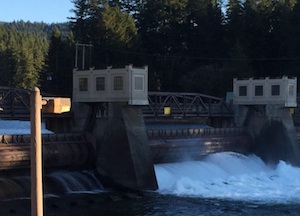
MWH Americas Inc. and a local contractor are battling a $5-million lawsuit connected to 100-ton gates on an Oregon dam that suddenly came crashing down.
The failure of two of the three 102-foot long roll gates at the Leaburg Dam on the McKenzie River was triggered by a “systemic design error” involving hydraulic hoists engineered by MWH and installed by Portland-based Advanced American Construction, claims the Eugene Water and Electric Board. It filed the lawsuit in federal circuit court in Eugene May 5th.
The municipal power company, which operates the dam to generate electricity for 86,000 homes and businesses in the Eugene area, said it is seeking to recover funds spent to replace allegedly defective hydraulic hoists with electric-powered ones.
EWEB’s lawsuit alleges breach of contract and negligence by Broomfield, Colo.-based MWH and Advanced American in their work on the new hoists, which lasted only a few years of operation.
“The defective design resulted in operational conditions that overwhelmed the hoist system after only a few years of operation,” states the power company’s complaint.
The dam provides control for diverting water into a canal that powers turbines while maintaining a constant river elevation.
Exactly what caused the gate or hoist failure remains unclear and unproven in court and the utility says tests on the rotor proved inconclusive. MWH said it is “disappointed” with the decision by the utility to sue.
“We do not believe the MWH design is related to the problems experienced by EWEB in the operation of the hoists,” MWH said in a statement.
Advanced American could not be reached for comment.
Planning for Dam
EWEB began planning more than a decade-and-a-half ago to replace the electric hoists on the dam, which had operated without failure since the 1920s.
Presented with a choice of electric or hydraulic hoists, the utility company said it went with the hydraulic model at MWH’s urging.
The new hoists have been operated since 2006 and were expected to last for 50 years, says EWEB.
However, just six years later, in 2012, the hoist on roll gate #2 stopped working. While it was almost completely up, EWEB claims, the gate “shuddered massively, produced a loud boom, and collapsed into the gate well,” according to the lawsuit.



Post a comment to this article
Report Abusive Comment